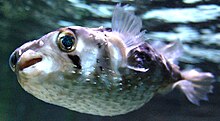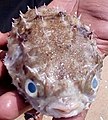| Porcupinefish Temporal range: Early Eocene to present PreꞒ Ꞓ O S D C P T J K Pg N | |
|---|---|

| |
| Diodon holocanthus | |
| Scientific classification | |
| Domain: | Eukaryota |
| Kingdom: | Animalia |
| Phylum: | Chordata |
| Class: | Actinopterygii |
| Order: | Tetraodontiformes |
| Suborder: | Tetraodontoidei |
| Family: | Diodontidae Bonaparte, 1838 |
| Genera | |
|
Allomycterus | |
Porcupinefish are medium-to-large fish belonging to the family Diodontidae from the order Tetraodontiformes which are also commonly called blowfish and, sometimes, balloonfish and globefish. The family includes about 18 species. They are sometimes collectively called pufferfish, not to be confused with the morphologically similar and closely related Tetraodontidae, which are more commonly given this name.
They are found in shallow, temperate, and tropical seas worldwide. A few species are found much further out from shore, wherein large schools of thousands of individuals can occur.
Taxonomy
Extant genera
The following genera are known:
- Allomycterus McCulloch, 1921
- Chilomycterus Brisout de Barneville, 1846
- Cyclichthys Kaup, 1855
- Diodon Linnaeus, 1758
- Dicotylichthys Kaup, 1855
- Lophodiodon Fraser-Brunner, 1943
- Tragulichthys Whitley, 1931
Fossil genera

The following genera are known only from fossil remains:
- †Eodiodon Casier, 1952 (Late Eocene of Belgium)
- †Heptadiodon Bronn, 1855 (Early Eocene of Italy)
- †Prodiodon Ladanois, 1955 (Early Eocene of Italy)
- †Progymnodon Dames, 1883 (mid-late Eocene of the United States and Romania)
- †Pshekhadiodon Bannikov & Tyler, 1997 (Middle Eocene of the North Caucasus, Russia)
- †Zignodon Tyler & Santini, 2002 (Early Eocene of Italy)
Characteristics
Porcupinefish are generally slow-moving.
They have the ability to inflate their bodies by swallowing water or air, thereby becoming rounder. This increase in size (almost double vertically) reduces the range of potential predators to those with much larger mouths. A second defense mechanism is provided by the sharp spines, which radiate outwards when the fish is inflated.
They have upper and lower teeth that fuse into a shape of a parrot's beak; they use this beak to eat molluscs and sea urchins.
Some species are poisonous, having tetrodotoxin in their internal organs, such as the ovaries and liver. This neurotoxin is at least 1,200 times more potent than cyanide. The poison is produced by several types of bacteria obtained from the fish's diet. As a result of these three defenses, porcupinefish have few predators, though adults are sometimes preyed upon by sharks and orcas. Juveniles are also preyed on by Lysiosquillina maculata, tuna, and dolphins.
Relationship with humans
Consumption
Porcupinefish are eaten as food fish and are an exotic delicacy in Cebu, Philippines, where they are called tagotongan. However, pufferfish can be dangerous to consume since they can cause tetrodotoxin poisoning.
In popular culture
The porcupine fish (as Diodon antennatus) is mentioned in Charles Darwin's famous account of his trip around the world, The Voyage of the Beagle. He noted how the fish can swim quite well when inflated, though the altered buoyancy requires them to do so upside down. Darwin also mentioned hearing a fellow naturalist, Dr. Allen of Forres, had "frequently found a Diodon, floating alive and distended, in the stomach of the shark; and that on several occasions he has known it eat its way, not only through the coats of the stomach, but through the sides of the monster".
Gallery
-
 A porcupinefish in an aquarium
A porcupinefish in an aquarium
-
 A dead porcupinefish with clearly visible spines on the shore
A dead porcupinefish with clearly visible spines on the shore
-
 Preserved porcupine fish in a laboratory
Preserved porcupine fish in a laboratory
-
 A dead porcupinefish washed up on a beach
A dead porcupinefish washed up on a beach
-
 A dead porcupinefish
A dead porcupinefish
- (video) Diodon nicthemerus swimming
See also
References
- Matsuura, Keiichi (January 2015). "Taxonomy and systematics of tetraodontiform fishes: a review focusing primarily on progress in the period from 1980 to 2014". Ichthyological Research. 62 (1): 72–113. doi:10.1007/s10228-014-0444-5.
- Myers, P.; Espinosa, R.; Parr, C. S.; Jones, T.; Hammond, G. S.; Dewey, T. A. (2023). "Diodontidae: Classification". Animal Diversity Web. University of Michigan Museum of Zoology. Retrieved 1 April 2023.
- Mills, D. (1993). Cooke, J. (ed.). Aquarium Fish. San Diego: Dorling Kindersley. pp. 281. ISBN 1-56458-293-0.
- ^ "Diodontidae - Porcupinefishes". Animal factsheets. Australian Museum. 18 June 2022. Retrieved 1 April 2023.
- ^ Matsuura, K.; Tyler, J.C. (1998). Paxton, J.R.; Eschmeyer, W.N. (eds.). Encyclopedia of Fishes. San Diego, California, USA: Academic Press. p. 231. ISBN 0-12-547665-5.
- "PBDB Taxon". paleobiodb.org. Retrieved 2025-01-01.
- Tyler, J. C.; Bannikov, A. F. (2009-11-01). "Phylogenetic implications of the some cranial features of the porcupine pufferfish Pshekhadiodon (Tetraodontiformes, Diodontidae) from the Eocene of the Northern Caucasus". Journal of Ichthyology. 49 (9): 703–709. doi:10.1134/S003294520909001X. ISSN 1555-6425.
- Dudley, Gordon; Sumich, James; Cass-Dudley, Virginia L. (2011). Laboratory and Field Investigations in Marine Life. Sudbury, Massachusetts, USA: Jones & Bartlett Publishers. p. 159. ISBN 978-1-4496-0501-8.
- Ponder, Winston Frank; Lindberg, David R.; Ponder, Juliet Mary (2019). Biology and Evolution of the Mollusca. Vol. 1. Boca Raton, Florida, USA: CRC Press. ISBN 978-1-351-11565-0.
- Piper, R. (2007), Extraordinary Animals: An Encyclopedia of Curious and Unusual Animals, Greenwood Press.
- Darwin, Charles (1845). Journal of Researches Into the Natural History and Geology of the Countries Visited During the Voyage of H.M.S. Beagle Round the World: Under the Command of Capt. Fitz Roy. J. Murray. p. 14.
External links
- [REDACTED] Media related to Diodontidae at Wikimedia Commons
- [REDACTED] Data related to Diodontidae at Wikispecies